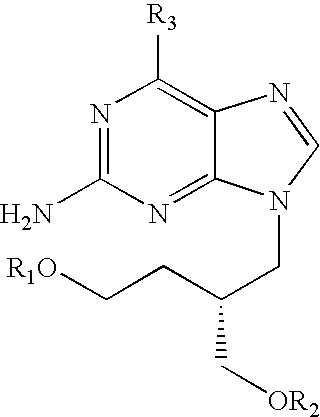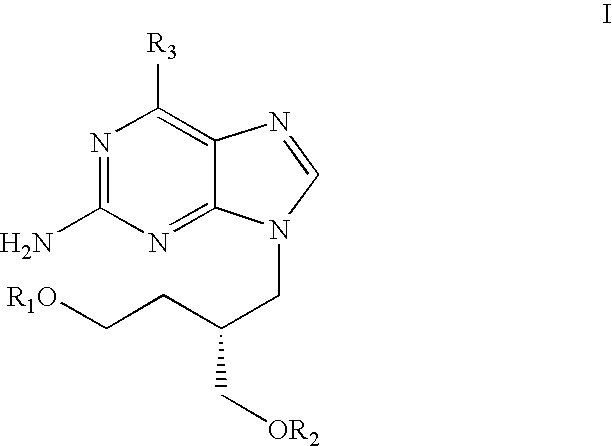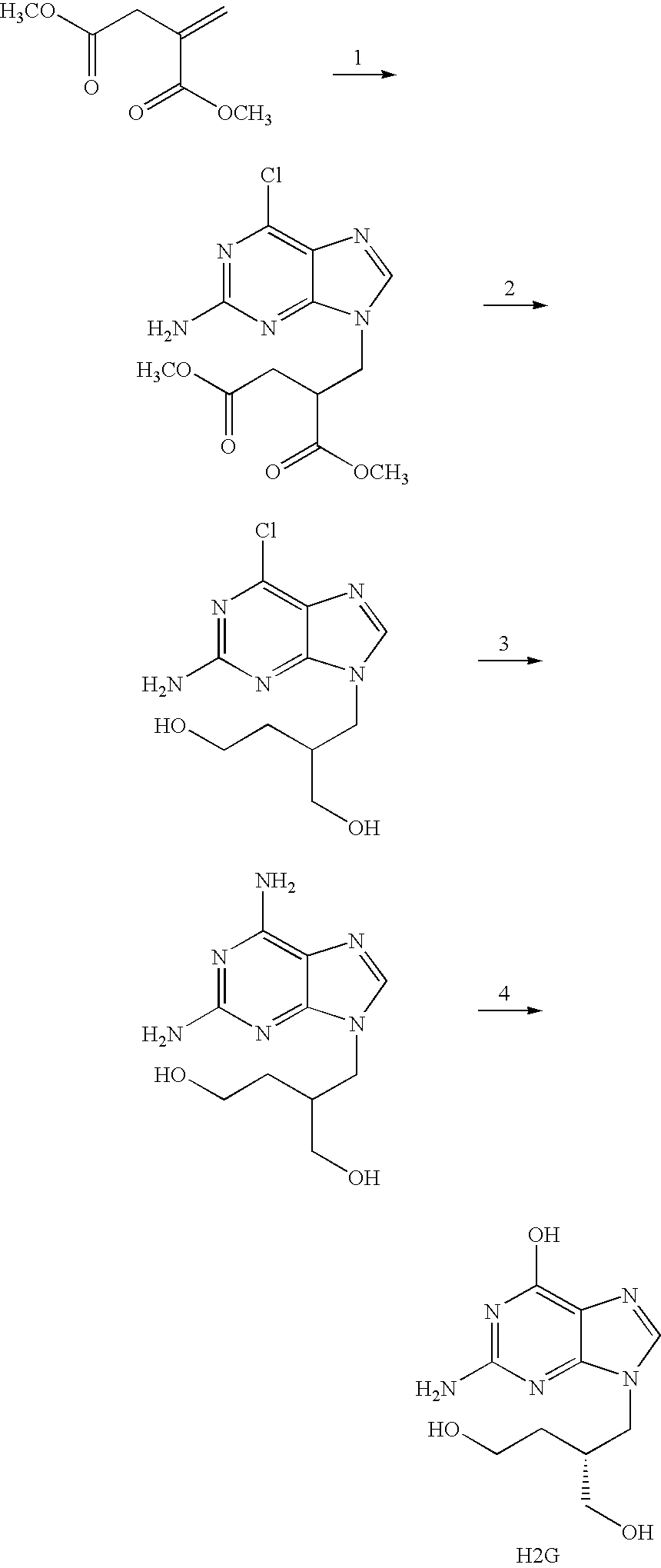Synthesis of acyclic nucleoside derivatives
a technology of acyclic nucleosides and derivatives, which is applied in the field of antivirals, can solve the problems that stearate esters may be detrimental to improving oral bioavailability, and achieve the effect of increasing purity of the resulting product and increasing throughpu
- Summary
- Abstract
- Description
- Claims
- Application Information
AI Technical Summary
Benefits of technology
Problems solved by technology
Method used
Image
Examples
example 2
(R)-9-[2-(Myristoyloxymethyl)-4-(L-valyloxy)butyl]guanine
[0295] The titled compound was obtained as the bistrifluoracetate salt in a manner analogous to Example 1 using myristoyl chloride instead of stearoyl chloride in step b).
[0296]1H NMR (250 MHz, DMSO-d6): δ 0.97 (t, 3H), 1.05 (dd, 6H), 1.34 (br s, 20H), 1.57 (m, 2H), 1.78 (m, 2H), 2.24 (m, 1H), 2.35 (t, 2H), 2.51 (m, 1H), 3.97-4.20 (m, 5H), 4.36 (t, 2H), 6.8 (br s, 2H), 8.2 (br s, 1H), 8.5 (br s, 3H), 11.1 (br s, 1H).
example 3
(R)-9-[2-(Oleoyloxymethyl)-4-(L-valyloxy)butyl]guanine
[0297] The titled compound was obtained as the bistrifluoroacetyl salt in a manner analogous to Example 1 using oleoyl chloride instead of stearoyl chloride in step b).
[0298]1H NMR (250 MHz, DMSO-d6): δ 0.96 (t, 3H), 1.05 (dd, 6H), 1.35 (br s, 20H), 1.59 (m, 2H), 1.76 (m, 2H), 2.09 (m, 4H), 2.24 (m, 1H), 2.35 (t, 2H), 2.50 (m, 1H), 3.97-4.17 (m, 5H), 4.35 (t, 2H), 5.43 (t, 2H), 6.7 (br s, 2H), 8.0 (br s, 1H), 8.5 (br s, 3H), 11.1 (br s, 1H).
example 4
(R)-9-[2-(Butyryloxymethyl)-4-(L-valyloxy)butyl]guanine
a) (R)-9-[4-(N-tert-Butoxycarbonyl-L-valyloxy)-2-(butyryloxymethyl) butyl]guanine
[0299] DCC (110 mg, 0.53 mmol) was dissolved in dichloromethane (10 ml) and butyric acid (82 mg, 0.93 mmol) was added. After 4 hours at room temperature the mixture was filtered and the filtrate was evaporated. The residue was dissolved in pyridine (5 ml) and (R)-9-[4-(N-tert-Butoxycarbonyl-L-valyloxy)-2-hydroxymethylbutyl]guanine (200 mg, 0.44 mmol) (Example 1, step a) was added. The mixture was stirred for 120 hours at room temperature. According to TLC the reaction was incomplete and more anhydride was made using the procedure above. This anhydride was added and the mixture was stirred for an additional 20 hours. The reaction mixture was evaporated and chromatographed first on silica gel and then on aluminium oxide, in both cases eluted with dichloromethane / methanol to give 79 mg of the intermediate product.
b) (R)-9-[2-(Butyryloxymethyl)-4-(L-...
PUM
 Login to View More
Login to View More Abstract
Description
Claims
Application Information
 Login to View More
Login to View More - R&D
- Intellectual Property
- Life Sciences
- Materials
- Tech Scout
- Unparalleled Data Quality
- Higher Quality Content
- 60% Fewer Hallucinations
Browse by: Latest US Patents, China's latest patents, Technical Efficacy Thesaurus, Application Domain, Technology Topic, Popular Technical Reports.
© 2025 PatSnap. All rights reserved.Legal|Privacy policy|Modern Slavery Act Transparency Statement|Sitemap|About US| Contact US: help@patsnap.com



